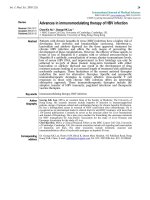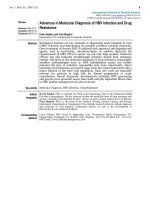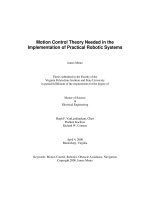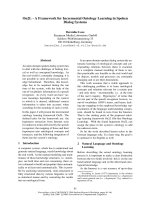david suendermann - advances in commercial deployment of spoken dialog systems
Bạn đang xem bản rút gọn của tài liệu. Xem và tải ngay bản đầy đủ của tài liệu tại đây (873.52 KB, 79 trang )
SpringerBriefs in Speech Technology
Series Editor:
Amy Neustein
For other titles published in this series, go to
/>Editor’s Note
The authors of this series have been hand-selected. They comprise some of the most outstanding scientists
– drawn from academia and private industry – whose research is marked by its novelty, applicability, and
practicality in providing broad based speech solutions. The SpringerBriefs in Speech Technology series
provides the latest findings in speech technology gleaned from comprehensive literature re views and
empirical investigations that are performed in both laboratory and real life settings. Some of the topics
covered in this series include the presentation of real life commercial deployment of spoken dialog
systems, contemporary methods of speech parameterization, deve lopments in information security for
automated speech, forensic speak er recognition, use of sophisticated speech analytics in call centers, and
an exploration of new methods of soft computing for improving human-computer interaction. Those in
academia, the pri vate sector, the self service industry, law enforcement, and government intelligence, are
among the principal audience for this series, which is designed to serve as an important and essential
reference guide for speech developers, system designers, speech engineers, linguists and others. In
particular, a major audience of readers will consist of researchers and technical experts in the automated
call center industry where speech processing is a key component to the functioning of customer care
contact centers.
Amy Neustein, Ph.D., serves as Editor-in-Chief of the International Journal of Speech Technology
(Springer). She edited the recently published book “Advances in Speech Recognition: Mobile Environ-
ments, Call Centers and Clinics” (Springer 2010), and serves as quest columnist on speech processing
for Womensenews. Dr. Neustein is Founder and CEO of Linguistic Te chnology Systems, a NJ-based
think tank for intelligent design of advanced natural language based emotion-detection software to
improve human response in monitoring recorded conversations of terr or suspects and helpline calls.
Dr. Neustein’s work appears in the peer review literature and in industry and mass media publications.
Her academic books, which cover a range of political, social and legal topics, have been cited in the
Chronicles of Higher Education, and have won her a pr o Humanitate Literary A ward. She serves on
the visiting faculty of the National Judicial College and as a plenary speaker at conferences in artificial
intelligence and computing. Dr. Neustein is a member of MIR (machine intelligence research) Labs,
which does advanced work in computer technology to assist underdeveloped countries in improving their
ability to cope with famine, disease/illness, and political and social affliction. She is a founding member
of the New York City Speech Processing Consortium, a newly formed group of NY-based companies,
publishing houses, and researcher s dedicated to advancing speech technology research and development.
David Suendermann
Advances in Commercial
Deployment of Spoken
Dialog Systems
123
David Suendermann
SpeechCycle, Inc.
26 Broadway 11th Floor
New York, NY 10004
USA
ISSN 2191-737X e-ISSN 2191-7388
ISBN 978-1-4419-9609-1 e-ISBN 978-1-4419-9610-7
DOI 10.1007/978-1-4419-9610-7
Springer New York Dordrecht Heidelberg London
Library of Congress Control Number: 2011930670
c
Springer Science+Business Media, LLC 2011
All rights reserved. This work may not be translated or copied in whole or in part without the written
permission of the publisher (Springer Science+Business Media, LLC, 233 Spring Street, New Yo rk,
NY 10013, USA), except for brief excerpts in connection with reviews or scholarly analysis. Use in
connection with any form of information storage and retrieval, electronic adaptation, computer software,
or by similar or dissimilar methodology now known or hereafter developed is forbidden.
The use in this publication of trade names, trademarks, service marks, and similar terms, ev e n if they are
not identified as such, is not to be taken as an expression of opinion as to whether or not they are subject
to proprietary rights.
Printed on acid-free paper
Springer is part of Springer Science+Business Media (
www.springer.com)
Preface
Spoken dialog systems have been the object of intensive research interest over the
past two decades, and hundreds of scientific articles as well as a handful of text
books such as [25, 52, 74, 79, 80, 83] have seen the light of day. What most of these
publications lack, however, is a link to the “real world”, i.e., to conditions, issues,
and environmen tal characteristics of deployed systems that process millions of calls
every week resulting in millions of dollars of cost savings. Instead of learning
about:
• Voice user interface design.
• Psychological foundations of human-machine interaction.
• The deep academic
1
side of spoken dialog system research.
• Toy examples.
• Simulated users.
the present book investigates:
• Large deployed systems with thousands of activities whose calls often exceed
20 min of duration.
• Technological advances in deployed dialog systems (such as reinforcement learn-
ing, massive use o f statistical language models and classifiers, self-adaptation,
etc.).
• To which extent academic approaches (such as statistical spoken language
understanding or dialog management) are applicable to deployed systems – if
at all.
1
This book draws a line between core research on spoken dialog systems as performed in academic
institutions and in large industrial research labs on the one hand and commercially deployed spoken
dialog systems on the other hand. As a convention, the former will be referred to as academic,the
latter as deployed systems.
v
vi Preface
To Whom It May Concern
There are three main statements touched upon above:
1. Huge commercial significance of deployed spoken dialog systems.
2. Lack of scientific publications on deployed spoken dialog systems.
3. Overwhelming difference between academic and deployed systems.
These arguments, further backed up in Chap. 1, indicate a strong need for a
comprehensive overview about the state of the art in deployed spoken dialog
systems. Accordingly, major topics covered b y the present book are as follows:
• After a brief introduction to the general architecture of a spoken dialog system,
Chap. 1 offers some insight into important parameters of deployed systems (such
as traffic, costs) before comparing the worlds of academic and deployed spoken
dialog systems in various dimensions.
• Architectural paradigms for all the components of deployed spoken dialog
systems are discussed in Chap. 2. T his chapter will also deal with the many
limitations deployed systems face (with respect to e.g. functionality, openness of
input/output language, performance) imposed by hardware requirements, legal
constraints, and the performance and robustness of current speech recognition
and understanding technology.
• The key to success or failure of deployed spoken dialog systems is their
performance. Performance being a diffuse term when it comes to the (continuous)
evaluation of dialog systems, Chap. 3 will be dedicated to why, what, and when
to measure performance of deployed systems.
• After setting the stage for a continuous performance evaluation, the logical
consequence is trying to increase system performance on an ongoing basis. This
attempt is often realized as a continuous cycle involving multiple techniques for
adapting and optimizing all the components of deployed spoken dialog systems
as discussed in Chap. 4. Adaptation and optimization are essential to deployed
applications because of two main reasons:
1. Every application can only be suboptimal when deployed for the first time
due to the absence of live data during the initial desig n phase. Hence,
application tuning is crucial to make sure deployed spoken dialog systems
achieve maximum performance.
2. Caller behavior, call r easons, caller characteristics, and business objectives
are subject to change over time. External events that can be of irregular (such
as network outages, promotions, political events), seasonal (college football
season, winter recess), or slowly progressing nature (slow migration from
analog to digital television, expansion o f the Smartphone market) may have
considerable effects on what type of calls an application must be able to
handle.
Due to the book’s focus on paradigms, processes, and techniques applied to
deployed spoken dialog systems, it will be of primary interest to speech scientists,
Preface vii
voice user interface designers, application engineers, and o ther technical staff of
the automated call center industry, probably the largest group of professionals in
the speech and language processing industry. Since Chap. 1 as well as several other
parts of the book aim at bridging the gap between academic and deployed spoken
dialog systems, the community of academic researchers in the field is in focus as
well.
New York City David Suendermann
February 2011
Acknowledgements
The n ame of the series which the present book is a volume of, SpringerBriefs, makes
use of two words that have a meaning in the German language: Springer (knight) and
Brief (letter). Indeed, I was fighting hard like a knight to get this letter done in less
than four months of sleepless nights. In this effort, several remarkable people stood
by me: Dr. Amy Neustein, Series Editor of the SpringerBriefs in Speech Technology,
whose strong editin g capabilities I learned to greatly appr eciate in a recent similar
project, kindly invited me to author the present monograph. Essential guidance and
support in the course of this knight ride came also from the editorial team at Springer
– Alex Greene and Andrew Leigh. On the final spurt, Dr. Roberto Pieraccini as well
as Dr. Renko Geffarth contributed invaluable reviews of the entire volume adding
the finishing touches to the manuscript.
ix
Contents
1 Deployed vs. Academic Spoken Dialog Systems 1
1.1 At-a-Glance 1
1.2 Census, Internet, and a Lot of Numbers 2
1.3 The Two Worlds 7
2 Paradigms for Deployed Spoken Dialog Systems 9
2.1 A Few Remarks on History 9
2.2 Components of Spoken Dialog Systems 11
2.3 Speech Recognition and Understanding 12
2.3.1 Rule-Based Grammars 12
2.3.2 Statistical Language Models and Classifiers 13
2.3.3 Robustness 14
2.4 Dialog Management 25
2.5 Language and Speech Generation 27
2.6 Voice Browsing 30
2.7 Deployed Spoken Dialog Systems are Real-Time Systems 33
3 Measuring Performance of Spoken Dialog Systems 39
3.1 Observable vs. Hidden 39
3.2 Speech Performance Analysis Metrics 42
3.3 Objective vs. Subjective 46
3.4 Evaluation Infrastructure 48
4 Deployed Spoken Dialog Systems’ Alpha and Omega:
Adaptation and Optimization 49
4.1 Speech Recognition and Understanding 50
4.2 Dialog Management 55
4.2.1 Escalator 55
xi
xii Contents
4.2.2 Engager 56
4.2.3 Contender 59
References 63
Chapter 1
Deployed vs. Academic Spoken Dialog Systems
Abstract After a brief introduction into the architecture of spoken dialog systems,
important factors of deployed systems (such as call volume, operating costs, or
induced savings) will be reviewed. The chapter also discusses major differences
between academic and commercially deployed systems.
Keywords Academic dialog systems • Architecture • Call automation • Call
centers • Call traffic • Deployed dialog systems • Erlang-B formula • Operating
costs and savings
1.1 At-a-Glance
Spoken dialog systems are today the most massively used applications of speech
and language technology and, at the same time, the most complex ones. They are
based on a variety of different disciplines of spoken language processing research
including:
• Speech recognition [25].
• Spoken language understanding [75].
• Voice user interface design [22].
• Spoken language generation [111].
• Speech synthesis [129].
As shown in Fig.
1.1, generally, a spoken dialog system receives input speech
from a conventional telephony or Voice-over-IP switch and triggers a speech
recognizer whose recognition hypothesis is semantically interpreted by the spoken
language understanding component. The semantic interpretation is passed to the
dialog manager hosting the system logic and communicating with arbitrary types of
backend services such as databases, web services, or file servers. Now, the dialog
manager generates a response generally corresponding to one or more pre-defined
D. Suendermann, Advances in Commercial Deployment of Spoken Dialog Systems,
SpringerBriefs in Speech Technology, DOI 10.1007/978-1-4419-9610-7
1,
© Springer Science+Business Media, LLC 2011
1
2 1 Deployed vs. Academic Spoken Dialog Systems
Fig. 1.1 General diagram of
a spoken dialog system
semantic symbols that are transformed into a word string by the language generation
component. Finally, a text-to-speech module transforms the word string into audible
speech that is sent back to the switch
1
.
1.2 Census, Internet, and a Lot of Numbers
In 2000, the U.S. Census counted 281,421,906 people living in the United States [1].
The same year, the Federal Communication Commission reported that common
telephony carriers handled 537 billion local calls that amount to over 5 daily calls
per capita on average [3]. While the majority of these calls were of a private nature , a
huge number were directed to customer care contact centers (aka call centers) often
serving as the main communication channel between a business and its customers.
Although over the past 10 years, Internet penetration has grown enormously (traffic
has increased by factor 224 [4]) and, accordingly, many customer care transactions
are carried out online, the amount of call center transactions of large businesses is
still extremely large.
For example, a large North-American telecommunications pr ovider serving a
customer base of over 5 million people received more than 40 million calls
into its service hotline in the time frame October 2009 through September 2010
[confidential source]. Considering that the average duration (aka handling time)
of the processed calls was about 8 min, the overall access m inutes of this period
(326 · 10
6
min) can be divided by the duration of the period (346 days = 525,600
min) to calculate the average number of concurrent calls. For the present example,
it is 621.
1
See Sect. 2.5 for differences in language and speech generation between academic and deployed
spoken dialog systems.
1.2 Census, Internet, and a Lot of Numbers 3
Fig. 1.2 Distribution of call traffic into the customer service hotline of a large telecommunication
provider
Does this mean, 621 call center agents are required all year round? No, this would
be considerably underestimated bearing in mind that traffic is not evenly distributed
throughout the day and the year.
Figure
1.2 shows the distribution of hourly traffic over the day for the above
mentioned service hotline averaged over the time period October 2009 through
September 2010. It also displays the average hourly traffic which is about 4,700
calls. The curve reaches a minimum of 334 calls, i.e. only the 15th part o f the
average, at 8AM UTC. Taking into account that the telecommunication company’s
customers are located in the four time zones o f the contiguous United States and that
they also observe daylight saving time, the time lap between UTC and the callers’
timezonevariesbetween4and8h.Inother words, minimum traffic is expected
sometime between 12 and 4AM depending on the actual location. On the o ther
hand, the curve’s peak is at 8PM UTC (12 to 4PM local time) with about 8,500
received calls which is a little less than twice the average.
Apparently, it would be an easy solution t o scale call center staff according to the
hours of the day, i.e., less people at night, more people in p eak hours. Unfortunately,
in the real world, the load is not as evenly distributed as suggested by the averaged
distribution of Fig.
1.2. This is due to a number of reasons including:
• Irregular events of predictable (such as promotion campaigns, roll-outs of new
products) or unpredictable nature (weather conditions, power outages).
• Regular/seasonal events (e.g., annual tax declaration, holidays), but also
• The randomness of when calls come in:
Consider the above mentioned minimum average hourly volume of n = 334 calls
and an average call length of 8 min. Now, one can estimate the probability that k
calls overlap as
p
k
(n, p) =
n
k
p
k
(1 − p)
(n−k)
(1.1)
4 1 Deployed vs. Academic Spoken Dialog Systems
with p = 8min/60 min. Equation (1.1) is the probability mass function of a
binomial distribution. If you had m call center agents, the probability that they
will be enough to handle all incoming traffic is
P
m
(n, p) =
m
k=0
p
k
(n, p) = I
1−p
(n − m, m + 1) (1.2)
with the regularized incomplete beta function I [5]. P
m
is smaller than 1 for m < n,
i.e., there is always a chance that agents will not be able to handle all traffic unless
there are as many agents as the total number of calls coming in, simply because,
theoretically, all calls could come in at the very same time. However, the likelihood
that this happens is very small and can be controlled by (
1.2), which, by the way,
can also be derived using the Erlang-B formula, a widely used statistical description
of load in telephony switching equipment [77]. For example, to make sure that call
center agents are capable of handling all incoming traffic in 99% of the cases, one
would estimate
ˆm = argmin
m
|P
m
(n, p) − 0.99|. (1.3)
For the above values for n and p, one can compute ˆm = 60. On the other hand, simply
averaging traffic as
¯m = np (1.4)
(which is the expected value of the binomial distribution) produces ¯m = 44.5.
Consequently, even if the average statistics of Fig.
1.2 would hold true, 45 agents
at 8 AM GMT would certainly not suffice. Instead, 60 agents would be necessary
to cover 99% of traffic situations without backlog. Figure 1.3 shows how the ratio
between ˆm and ¯m evolves for different amounts of traffic given the above defined p.
The higher the traffic, the closer the ratio gets to the theoretical 1.0 where as many
agents are required as suggested by the averaged load.
In addition to the expected unbalanced load of traffic, the above listed irregular
and regular/seasonal events lead to a significantly higher variation of the load. To
get a more comprehensive picture of this variation, every hour’s traffic throughout
the collection period was measured individually and displayed in Fig.
1.4 in order
of decreasing load.
This graph (with a logarithmic abscissa) shows that, over more than 15% of
the time, traffic was higher than twice the average (displayed as a dash ed line in
Fig. 1.4) and that there were o ccasions when traffic exceeded the quadruple average.
Again, assuming that e.g. 99% of the situations (including exceptional ones) are to
be handled without backlog, one would still need to handle situations of up to 12,800
incoming calls per hour producing ˆm = 1,797.
This number shows that there would have to be several thousand call center
agents available to deal with this traffic unless efficient automated self-service
solutions are deployed to complement the task of human agents. Call center
1.2 Census, Internet, and a Lot of Numbers 5
1.0
1.2
1.4
1.6
1.8
2.0
2.2
2.4
2.6
2.8
3.0
10 100 1000 10000 100000
Fig. 1.3 Ratio between ¯m and ˆm depending on the number of calls per hour with p = 8min/60 min
and 99% coverage without backlog
Fig. 1.4 Hourly call traffic
into the customer service
hotline of a large
telecommunication provider
measured over a period of
one year in descending order
0
5000
10000
15000
20000
1 10 100 1000 10000
hourly traffic
average traffic
automation by means of spoken dialog systems thus can bring very large savings
considering that [10]:
1. The average cost to recruit and train per agent is between $8,000 and $12,000.
2. Inbound centers have an average annual turnover of 26%.
3. The average hourly wage median is $15.
Assuming a gross number of 3,000 agents for the above customer, (1) would produce
some $24M to $36M just for the initial agent recruiting and training. (2) and (3)
combined would produce a yearly additional expense of almost $90M if the whole
traffic would be handled entirely by human agents.
In contrast, if certain (sub-)tasks of the agent loop would be carried out by
automated spoken dialog systems, costs could b e significantly reduced. Once a
6 1 Deployed vs. Academic Spoken Dialog Systems
spoken dialog system is built, it is easily scalable just by rolling out the respective
piece of software on additional servers. Consequently, (1) and (2) are minimal. The
operating costs of a deployed spoken dialog system including hosting, licensing, or
telephony fees would usually be in the range of a few cents per minute, drastically
reducing the hourly expense projected by (3). These considerations highly support
the use of automated spoken dialog systems to take over certain tasks in the realm
of the business of customer contact centers such as, for instance:
• Call routing [141]
• Billing [38]
•FAQ[30]
• Orders/sales [40]
• Hours, branch, department, and product search [20]
Tabl e 1.1 Major differences between academic and deployed spoken dialog systems
Area Academic systems Deployed systems Further reading
1 Speech
recognition
Statistical language
models
Rule-based grammars,
few statistical
language models
Sections 2.3.1
and 2.3.2
2 Spoken language
understanding
Statistical named entity
tagging, semantic
tagging, (shallow)
parsing [9, 78,87]
Rule-based grammars,
key-word spotting,
few statistical
classifiers
[54, 120, 128]
Sections 2.3.1
and 2.3.2
3 Dialog
management
MDP, POMDP,
inference [63, 66,
143]
Call flo w, form-
filling [86, 89, 108]
Section 2.4
4 Language
generation
Statistical, rule-based Manually written
prompts
Section 2.5
5 Speech generation Text-to-speech
synthesis
Pre-recorded prompts Section 2.5
6 Interfaces Proprietary VoiceXML, SRGS,
MRCP, ECMAScript
[19, 32, 47, 72]
Sections 2.6
and 2.3.1
7Dataand
technology
Often published and
open source
Proprietary and
confidential
8 Typical dialog
duration
40 s, 5 turns [29] 277 s, 10 turns
[confidential source]
9 Corpus size 100s of dialogs, 1000s
of utterances [29]
1,000,000s of dialogs
and utterances [118]
10 Typical
applications
Tourist information,
flight booking, bus
information [28, 65,
96]
Call routing, package
tracking, phone
billing, phone
banking, technical
support [6,43,76,88]
11 Number of
scientific
publications
Many Few
1.3 The Two Worlds 7
• Directory assistance [108]
• Order/package tracking [107]
• Technical support [6] or
• Surveys [112].
1.3 The Two Worlds
For over a decade, spoken dialog systems have proven their effectiveness in com-
mercial deployments automating billions of phone transactions [142]. For a much
longer period of time, academic research has focused on spoken dialog systems as
well [90]. Hundreds of scientific publications on this subject are produced every
year, the vast majority of which originate from academic research groups.
As an example, at the recently held Annual Conference of the International
Speech Communication Association, Interspeech 2010, only about 10% of the
publications on spoken dialog systems came from people working on deployed
systems. The remaining 90% experimented with:
• Simulated users, e.g. [21, 55, 91,92].
• Conversations recorded using recruited subjects, e.g. [12, 49, 62,69], or
• Corpora available from standard sources such as the Linguistic Data Consortium
(LDC) or the Spoken Dialog Challenge, e.g. [97].
Now, the question arises on how and to which extent the considerable endeavor of
the academic research community affects what is actually happening in deployed
systems. In an attempt to answer this question, Table
1.1 compares academic and
deployed systems along multiple dimensions specifically reviewing the five main
components shown in Fig.
1.1. It becomes obvious that differences dominate the
picture.
Chapter 2
Paradigms for Deployed Spoken Dialog Systems
Abstract This chapter covers state-of-the-art paradigms for all the components of
deployed spoken dialog systems. With a f ocus on speech recognition and under-
standing components as well as dialog management, the specific requirements of
deployed systems will be discussed. This includes their robustness against distorted
and unexpected user input, their real-time-ability, and the need for standardized
interfaces.
Keywords Components of spoken dialog systems • Confirmation • Dialog man-
agement • Language generation • Natural language call routing • Real-time
systems • Rejection • Robustness • Rule-based grammars • Speech recognition
• Speech understanding • Speech synthesis • Statistical classifiers • Statistical
language models • Voice browsing • VoiceXML
2.1 A Few Remarks on History
After half a century of intensive research into automatic speech recognition (one of
the first published functional speech recognizers was built at Bell Labs in 1952 [27]),
in the 1990s, the technology finally achieved a performance (in terms of accuracy
and speed) that could be applied to simple tasks in the telephony systems of
companies with large customer care call volume. Solutions to phone-based self-
service using touch-tone interaction already existed. Now, applications could be
speech-enabled allowing for a much wider range of solutions helping companies like
FedEx, American Airlines, or UPS to effectively expand their self-service customer
support offerings [88]. Applications ranged from package tracking (with a tracking
number specified by the caller) to stock quotes and flight schedule information.
D. Suendermann, Advances in Commercial Deployment of Spoken Dialog Systems,
SpringerBriefs in Speech Technology, DOI 10.1007/978-1-4419-9610-7
2,
© Springer Science+Business Media, LLC 2011
9
10 2 Paradigms for Deployed Spoken Dialog Systems
Speech-enabled menus have clear advantages compared to touch-tone menus when
it comes to:
• Input items distinguishing a large number of types (such as city names or stock
listings) or
• Mixed initiative or over-specification – when spoken language understanding
and dialog manager are d esigned accordingly, the caller can input information
or formulate requests unexpected at the current point of the dialog, e.g.
S: Where would you like to depart from?
C: From JFK on January 5th.
Another milestone in the development of spoken dialog systems was the introduc-
tion of natural language call routing in 1997 by researchers at AT&T Labs [43].
Large companies (as AT&T itself) often have a single service hotline phone number
that serves as a portal to a variety of services and call center departments with
different skills. There can be dozens if not hundreds of d ifferent destinations
conventionally requiring a multi-layered menu struc ture to get the caller to the right
place as shown in the f ollowing dialog recorded from the service hotline of a cable
provider:
S: Which one can I help you with: Your bill, tech support, an order, an appointment, or a
change to your service?
C: Repeat.
S: Just say: My bill,orpress1.Tech support,orpress2.An order,orpress3.An
appointment, or press 4. Or say make a change to my service,orpress5.
C: Tech support.
S: And which one are you having problems with: Internet, e-mail, cable TV, or telephone?
C: My telephone.
S: Are you ha ving trouble with the dial tone on your phone?
C: Nay.
S: Then, do you have a question about a feature on your phone such as voicemail or call
forwarding?
C: Yeah.
S: You can say voice mail, caller ID,orcall forwarding. If it is not one of those, say help
me with something else.
C: Repeat the message, please.
S: Just say: Voic e m ail,orpress1.Caller ID,orpress2.Call forwarding,orpress3.Or,if
it is not one of those, say help me with something else,orpress4.
C: Help me with something else.
S: Here are some others to choose from: Call waiting, three-way calling, speed dialing, call
return, anonymous call rejection, or custom ring. Again, if it is not one of these, say help
me with something else.
C: Three-w a y calling.
S: I can explain you how three-way calling works or help you with problems with it. Just
say instructions or problems. Or you can say help me with something else.
C: Problems.
In contrast, a conversation using a natural language call router with an open-ended
question could have been
S: Briefly tell me what you are calling about today.
C: My three-way calling is not working.
2.2 Components of Spoken Dialog Systems 11
Apparently, this type of prompting comes along with a much shorter handling time
resulting in a number of substantial advantages:
• Handling fees are saved (considering the processing of millions of su ch calls, the
shaving of just seconds for every call can result in a significant impact on the
application’s bottom line).
• By reducing the number of recognition events necessary to get a caller to the
right place, the chance o f recognition errors decreases as well (even though it
is true that open-ended question contexts perform worse than directed dialog,
e.g., 85% vs. 95% True Total
1
, the fact that doing several of the latter in a
row exponentially decreases the chance that the whole conversation completes
without error – e.g. the estimated probability that five user turns get completed
without error is (95%)
5
= 77% which is already way lower than the performance
of the open-ended scenario; for further reading o n measuring p erformance, see
Chap. 3). Reducing recognition errors raises the chance of automating the call
without intervention o f a human agent.
• User experience is also positively influenced by shortening handling time, reduc-
ing recognition errors, and conveying a smarter behavior of the application [35].
• Open-ended prompting also p revents problems with callers not understanding
the options in the menu and choosing the wrong one resulting in potential
misroutings.
The underlying principle of natural language call routing is the automatic mapping
of a user utterance to a finite number of well-defined classes (aka categories, slots,
keys, tags, symptoms, call reasons, routing points, or buckets). For instance, the
above utterance
My three-way calling is not working
was classified as Phone
3WayCalling Broken, in a natural language call routing
application distinguishing more than 250 classes [115]. If user utterances are too
vague or out of the application’s scope, additional directed disambiguation questions
may be asked to finally route the call. Further details on the specifics of speech
recognition and understanding paradigms used in deployed spoken dialog systems
are given in Sect. 2.3.
2.2 Components of Spoken Dialog Systems
As introduced in Sect. 1.1 and depicted in Fig. 1.1, spoken dialog systems con-
sist of a number of components (speech recognition and understanding, dialog
manager, language and speech generation). In the following sections, each of
1
See Sect. 3.2 for the definition of this metric.
12 2 Paradigms for Deployed Spoken Dialog Systems
these components will be discussed in more detail focusing o n deployed solutions
and d rawing brief comparisons to techniques primarily used in academic research
to date.
2.3 Speech Recognition and Understanding
In Sect.
2.1, the use of speech recognition and understanding in place of the formerly
common touch-tone technology was motivated. This section gives an overview
about techniques primarily used in deployed systems as of today.
2.3.1 Rule-Based Grammars
In order to commercialize speech recognition and understanding technology for
their application in dialog systems, at the turn of the millennium, companies
such as Sun Microsystems, SpeechWorks, and Nuance made the concept of
speech recognition grammar popular among developers. Grammars are essentially
a specification “of the words and patterns of words to be listened for by a speech
recognizer” [47,128]. By restricting the scope of what the speech recognizer “listens
for” to a small number of phrases, two main issues of speech recognition and
understanding technology at that time could be tackled:
1. Before, large-vocabulary speech recognizers had to recognize every possible
phrase, every possible combination of words. Likewise, the speech understanding
component had to deal with arbitrary textual input. This produced a significant
margin of error unacceptable for commercial applications. By constraining
the recognizer with a small number of possible phrases, the possibility of
errors could be greatly reduced, assuming that the grammar covers all of the
possible caller inputs. Furthermore, each of the possible phrases in a grammar
could be uniquely and directly associated with a predefined semantic symbol,
thereby providing a straightforward implementation of the spoken language
understanding component.
2. The strong restriction o f the recognizer’s scope as well as the straightforward
implementation of the spoken language understanding component significantly
reduced the required computational load. This allowed speech servers to pro-
cess multiple speech recognition and understanding operations simultaneously.
Modern high-end servers can individually process more than 20 audio inputs at
once [2].
Similar to the industrial standardization endeavor on VoiceXML described in
Sect.
2.6, speech recognition grammars often follow the W3C Recommendation
SRGS (Speech Recognition Grammar Specification) published in 2004 [47].
2.3 Speech Recognition and Understanding 13
2.3.2 Statistical Language Models and Classifiers
Typical contexts for the use of rule-based grammars are those where caller responses
are highly constrained by the prompt such as:
• Yes/No questions (Are you calling because you lost your Internet connection?).
• Directed dialog (Which one best describes your problem: No picture, missing
channels, error message, bad audio ?).
• Listable items (city names, phone directory, etc.).
• Combinatorial items (phone numbers, monetary amounts, etc.).
On the other hand, there are situations where rule-based grammars prove impractical
because of the large variety of user inputs. Especially, responses to open prompts
tend to vary extensively. For example, the problem collection of a cable TV
troubleshooting application uses the following prompt:
Briefly tell me the problem you are having in one short sentence.
The total number of individual collected utterances of this context was so large
that the rule-based grammar resulting fro m the entire data used almost 10 0 MB
memory which proves unwieldy in p roduction server environments with hundreds
of recognition contexts and dozens of concurrent calls. In such situations, the use of
statistical language models and classifiers (statistical grammars) is recommendable.
By generally treating an open p rompt such as the one above as a call routing problem
(see Sect.
2.1), every input utterance is associated with exactly one class (the routing
point). For instance, responses to the above open prompt and their associated classes
are:
Um, the Korean channel doesn’t work well Channel Other
The signal is breaking up Picture
PoorQuality
Can’t see HBO Channel
Missing
My remote control is not working Remote
NotWorking
Want to purchase pay-per -view Order
PayPerView Other
This type of mapping is generally produced semi-automatically as further discussed
in Sect. 4.1.
The utterance data can be used to train a statistical language model that is applied
at runtime by the speech recognizer to generate a recognition hypothesis [100].
Both the u tterances and the associated classes can be used to train statistical
classifiers that are applied at runtime to map the recognition hypothesis to a semantic
hypothesis (class). An overview about state-of-the-art classifiers used for spoken
language understanding in dialog systems can be found in [36].
The initial reason to com e up with the r ule-based grammar paradigm was that of
avoiding too complex search trees common in large-vocabulary continuous speech
recognition (see Sect.
2.3.1). This makes the introduction of statistical grammars
for open prompts as done in this section sound a little paradoxical. However, it turns
out that, surprisingly to the most common intuition, statistical grammars seem to
always outperform even very carefully designed rule-based grammars when enough
14 2 Paradigms for Deployed Spoken Dialog Systems
training data is available. A respective study with four dialog systems and more
than 2,000 recognition contexts was conducted in [120]. The apparent reason for
this paradox is that in contrast to a general large-vocabulary language model trained
on millions of word tokens, here, strongly context-dependent information was used,
and statistical language models and classifiers were trained based only on data
collected in the very context the models were later used in.
2.3.3 Robustness
Automatic speech recognition accuracy kept improving greatly over the last six
decades since the first studies at Bell Laboratories in the early 1950s [27]. While
some people claim that improvements have amounted to about 10% relative word
error rate (WER
2
) reduction every year [44], this is factually not correct: It would
mean that the error rate of an arbitrarily complex large-vocabulary continuous
speech recognition task as of 2010 would be around 0.2% when starting at 100%
in 1952. It is more reasonable to assume the y early relative WER reduction being
around 5% on average resulting in some 5% absolute WER as of today. This
statement, however, is true for a trained, known speaker using a high-quality
microphone in a room with echo cancellation [44]. When it comes to speaker-
independent speech recognition in typical phone environments (including cell
phones, speaker phones, Voice-over-IP, background noise, channel noise, echo, etc.)
word error rates easily exceed 40% [145].
This sounds disastrous. How can a commercial (or any other) spoken dialog
system ever be practically deployed when 40% of its recognition events fail?
However, there are three important considerations that have to be taken into account
to allow the use of speech recognition even in situations where the error rate can be
very high [126]:
• First of all, the dialog manager does not use directly the word strings produced
by the speech recognizer, but the product of the language understanding (SLU)
component as shown in Fig. 1.1. The reader may expect that cascading ASR
and SLU may increase the chance of failure since both of them are error-prone,
and errors should grow rather than diminish. However, as a matter of fact, the
combination of ASR and SLU has proven very effective when the SLU is robust
enough to ignore insignificant recognition errors and still map the speech input
to the right semantic interpretation.
Here is an example. The caller says I wanna speak to a n a ssociate,andthe
recognizer hypothesizes on the time associate which amounts to 5 word errors
2
Word error rate is a common performance metric in speech recognition. It is based on the Leven-
shtein (or edit) distance [64] and divides the minimum sum of word substitutions, deletions, and
insertions to perform a word-by-word alignment of the recognized word string to a corresponding
reference transcription by the number of tokens in said r eference.









